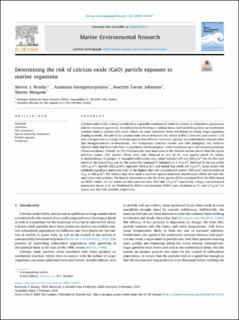| dc.contributor.author | Brooks, Steven | |
| dc.contributor.author | Georgantzopoulou, Anastasia | |
| dc.contributor.author | Johansen, Joachim Tørum | |
| dc.contributor.author | Mengede, Martin | |
| dc.date.accessioned | 2020-12-01T09:49:52Z | |
| dc.date.available | 2020-12-01T09:49:52Z | |
| dc.date.created | 2020-09-07T11:49:58Z | |
| dc.date.issued | 2020 | |
| dc.identifier.citation | Marine Environmental Research. 2020, 156. | en_US |
| dc.identifier.issn | 0141-1136 | |
| dc.identifier.uri | https://hdl.handle.net/11250/2711111 | |
| dc.description.abstract | Calcium oxide (CaO) is being considered as a possible treatment for both the control of echinoderm populations and the treatment against sea lice infestation in Norwegian salmon farms. CaO particles produce an exothermal reaction when in contact with water, which can cause epidermal burns and lesions to certain target organisms leading to death. The aim of the present study was to determine the effects of fine (<0.8 mm) and coarse (<2.5 mm) CaO particles to a range of marine species from different taxonomic groups: two echinoderms (Asterias ruben and Strongylocentrotus droebachiensis); two crustaceans (Carcinus maenas and Tisbe battagliai); two molluscs (Mytilus edulis and Hinia reticulata); a polychaete (Nereis pelagica); a fish (Cyclopterus sp.); and seaweed germlings (Fucus vesiculosus). Overall, the fine CaO particles were more toxic to the selected marine species than the coarse particles. Coarse CaO particle effects were only observed in four of the nine species tested (A. rubens, S. droebachiensis, N. pelagica, T. battagliai) with similar LC50 values between 207 and 268 g/m2. For the fine CaO particles, the lowest LC50 was for the epibenthic copepod (T. battagliai) at 3.14 g/m2, followed by the sea urchin (20.1 g/m2), starfish (22.2 g/m2), ragworm (29.6 g/m2), and netted dog whelk (41.9 g/m2). Lump sucker fish exhibited significant mortalities only at the highest fine CaO concentration tested (320 g/m2) and recorded an LC50 of 226 g/m2. The toxicity data were used to generate species sensitivity distributions (SSDs) for both fine and coarse CaO particles. The hazard concentrations for 5% of the species (HC5) calculated from the SSDs, based on NOEC values, for the coarse and fine particles were 35.5 and 1.5 g/m2 respectively. Using a recommended assessment factor of 5, the Predicted No Effect Concentration (PNEC) was calculated as 7.1 and 0.3 g/m2 for coarse and fine CaO particles respectively. | en_US |
| dc.language.iso | eng | en_US |
| dc.publisher | Elsevier | en_US |
| dc.rights | Navngivelse 4.0 Internasjonal | * |
| dc.rights.uri | http://creativecommons.org/licenses/by/4.0/deed.no | * |
| dc.title | Determining the risk of calcium oxide (CaO) particle exposure to marine organisms | en_US |
| dc.type | Peer reviewed | en_US |
| dc.type | Journal article | en_US |
| dc.description.version | publishedVersion | en_US |
| dc.rights.holder | © 2020 The Authors | en_US |
| dc.source.pagenumber | 9 | en_US |
| dc.source.volume | 156 | en_US |
| dc.source.journal | Marine Environmental Research | en_US |
| dc.identifier.doi | 10.1016/j.marenvres.2020.104917 | |
| dc.identifier.cristin | 1827718 | |
| dc.source.articlenumber | 104917 | en_US |
| cristin.ispublished | true | |
| cristin.fulltext | original | |
| cristin.qualitycode | 2 | |

